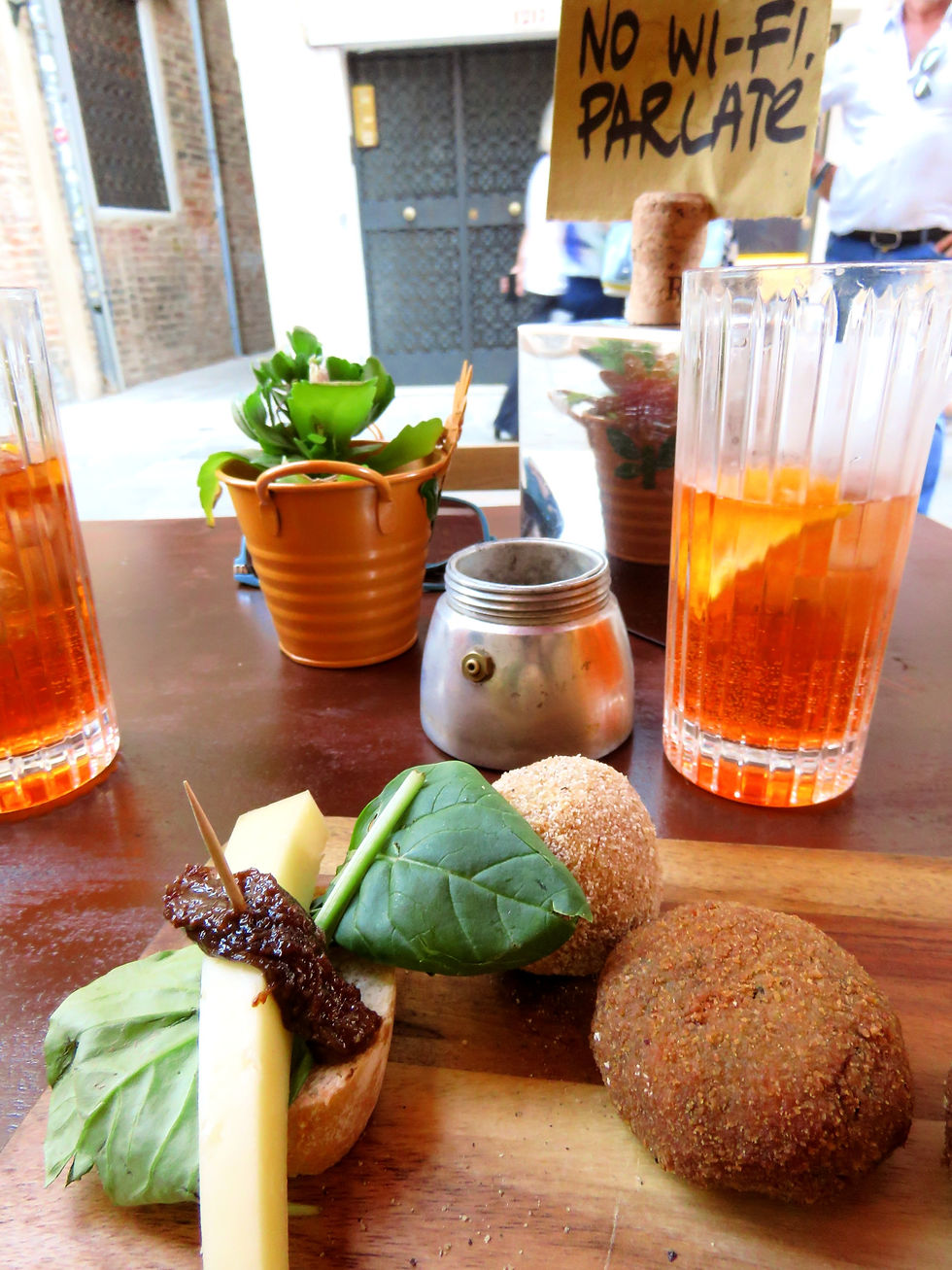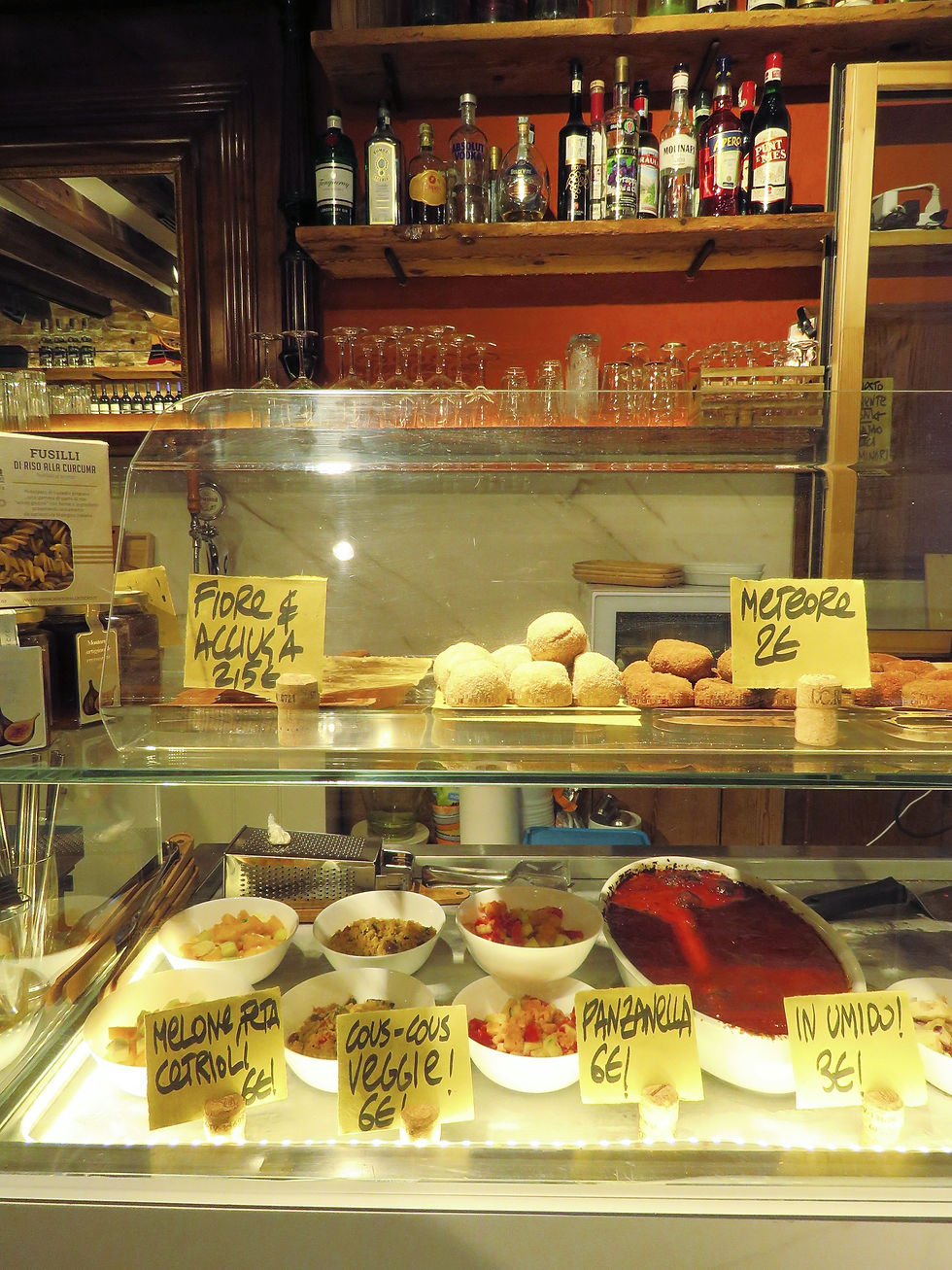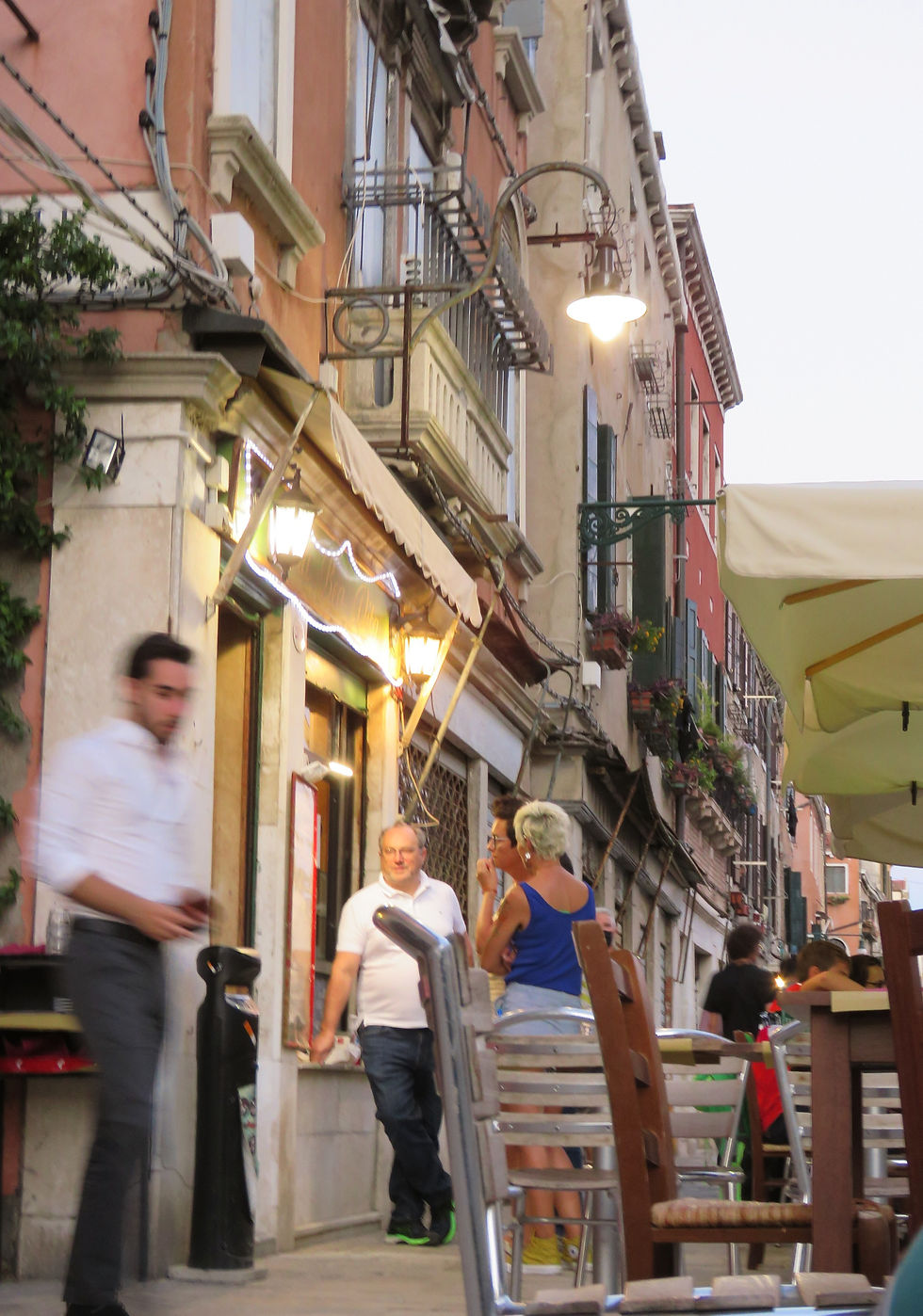What to Order in Venice
- Mangia Mangia

- Jun 10, 2022
- 8 min read
Updated: Sep 17, 2024
This unique city boasts a rich past of merchant sea-trading with dishes, spices and ingredients from afar but thrives on fresh seafood from the lagoon and local Veneto produce - so what's for lunch? Here's what to order in Venice.

Over 116 tiny islands connected by 403 bridges make up Venice, capital of the Veneto region. Venice is famously unique and we all know why but it's also tiny! Only 8 square kilometres of surface area belong to the city, yet there are so many quite piazze and calle you can get lost in, where you'd never feel you were visiting.
Having formed a powerful hub of trade between the East and West, Venice's strategic position during the 14th century enriched Italy's culinary bounty with spices and products from afar. The wealth due to their monopoly on the salt trade meant they were buying in tomatoes and corn from America and spices and rice from the East. Pepper, mace, nutmeg and cinnamon all featured here and still do. Traditionally there's always been a medley of local produce and exotic ingredients for the wealthy with a lot more to choose from but all-in-all Venice is a coastal city, seated on a lagoon, so there is one main contender in the culinary contest here, and that's seafood.
These days, strolling the streets (called calle) of Venice, you'll find many a restaurant with a tourist menu - indeed, Italy's most classically famous dishes are divine in themselves, we're talking spaghetti con ragù/carbonara/le vongole, pizza or lasagne maybe. And yes, these will be delicious in their own right, it's Italy, all food is delicious. But the country is divided regionally and every region is unique in their own cuisine with Venice's as uniquely Venetian as the city itself. So avoid the tourist menus, as tempting as they may be, and keep strolling. Here's a tip: branch off the main drag into the tiniest of calle, they'll lead you to intimate piazze and little restaurants tucked away into corners, these are the ones to go for.
You may struggle if you're not a lover of seafood and also if you are vegetarian but do not despair because Italy is abreast, if not two steps ahead, of allergen-conscious, vegetarian and vegan food culture and while you may not find classic dishes like Baccalà Mantecato without dairy or Risi e Bisi without meat, there are always options, one just needs to dig deeper and check with your waiter.

Cicheti
Seasonal appetisers in the form of crostini, mozzarella in carrozza, polpette and la frittura.
Kick off your Venetian dinner with an aperitivo in the form of an Aperol Spritz or two along Rio della Misericordia and a couple of cicheti. These will be displayed in glass cabinets in bacari (rustic Venetian wine bars). Be adventurous and pick any but we'd say try the Baccalà Mantecato and a polpetta di tonno if you're stuck.
Baccalà is an example of Venice's far-fetching trading powers from the past. Norwegian cod has found its way into the Venetians' hearts in the form of dried fish. This is brought back to life cooked in milk and mixed into a pulp with olive oil forming a sort of creamy, white pâté which is served on crostini or toasted polenta. It's delicate and moreish and must be tried!
Polpette are meat balls but can also be tuna balls or aubergine balls - anything rolled into a ball and deep-fried but oh the selection! Try the vegetarian options too! Any Venetian polpetta is bound to make you consider immediately ordering another two but resist, knowing that this is merely the beginning of a long, delectable dinner.
Mozzarella in carrozza is another interesting one, before we move on. This is mozzarella with an anchovy or two sandwiched between slices of white bread, deep-fried. Sounds odd? Try it. Locals swear the best spot is Rosticceria Gislon for these, otherwise venture onto the mainland over the long bridge to Mestre as some tend to do.
For a snack or an abbondante chiceto, try the tramezzini - have a read here of the best ones.

Antipasti
No the chiceto is not the antipasto, those are merely the finest of drinking snacks.
So, antipasti (appetisers) will be served where you sit down to eat your meal, you'll look at your menu or a chalk-board on the wall and you'll have to choose between some rather oddly-sounding options often in local dialect, let's help you out:
Schie co' polenta - these are tiny shrimps from the lagoon served on soft yellow or white polenta. Polenta is classically Veneto and can be served soft or solid and sometimes toasted.
Sarde in soar - the soar method of preserving dates back to the Middle Ages and was popular with Venetian fishermen and sailors. Sardine fillets are fried and marinated in vinegar, onions, raisins and pine nuts and served on polenta. You'll find this traditional agrodolce (sweet/sour) dish all over town, it's worth a taste for a real flavour of Venice - ancient and unusual - see what you think!

Primi
Moving on to the first of the main courses, i primi means 'the first', secondi means second. These dishes are usually staples so expect pasta, rice, gnocchi, polenta. Venice's pasta is bigoli - thick spaghetti made with buckwheat/wholewheat and traditionally eggs, although there are many variations. This is often served with salsa - a rich salted-sardine/anchovy and onion sauce.
Risi e bisi is another signature dish - made with Valone Nano Rice grown near Verona, this is a liquid risotto made with fresh garden peas and pancetta cooked in pea-shell broth.
On April 25th, the celebrated St. Mark's Day, this humble dish was traditionally served to the Doge of Venice by the locals. Rice is a sign of prosperity and fertility, it's thrown upon newlyweds outside Italian churches as confetti for this reason, but the simple Risi e Bisi (meaning rice and peas in Venetian-dialect) has become sought-after all year round, although it must be said the best time to order this dish is when peas are in season in late spring. Look out for it on menus in trattorie and osterie as a wonderful option if seafood doesn't float your boat.
Cuttlefish ink is used throughout Venice as a flavoursome addition to a range of authentic dishes. Known as nero di seppia, it may be added to dry pasta and seafood dishes but most famously turns a seafood risotto jet black! Risotto al nero di seppia is a must try, especially if you love seafood and if you love Venice. You'll find this on the menu everywhere.
Pasta e fasioi (pasta and beans in local dialect) is an example of cucina povera that's divine on a cold, foggy day. Barlotti beans are slow-cooked and made into a sauce which the pasta boils in. It's thick, creamy and not necessarily vegetarian, so do check first.
Risoto de gò is as Venetian as it gets. Gò is dialect for the Black Goby, native to the lagoon, it was fished as a simple, cheap food and eaten in risotto or on piadine, but these days Gò has become a delicacy so if you see it on the menu, that's a good sign!
If you're feeling less adventurous, you can always count on the calamari fritti (expect tentacles) and simple seafood dishes like spaghetti di seppie (squid), ai frutti di mare (seafood) or con le cozze (with mussels) all over town which will be beautifully prepared with freshly-caught seafood. Lagoon fish, like Mediterranean fish, is salty, small and packs flavour.

Secondi
If you still have space and love your meats, fegato alla veneziana is calf liver cooked with stewed onions, olive oil, and white wine, served with creamy polenta. It's a beautiful Venetian dish, perfectly balanced between sweet and earthy. There are many meaty options in Venice with a wealth of farmed produce on the main land - duck, veal and pork with tasty cold meats to try on a tagliere (wooden aperitivo board) like sorpressa and coppa. Order radicchio di treviso as a contorno (side dish) if it's season starting late October.
Something extra special:
In Spring and Autumn, green, lagoon Moleca crabs (Moeche in dialect) discard their shells remaining vulnerable to fishermen ready and waiting with nets in the crucial hours before their new shells harden in the water. Harvested twice a year, they're deep-fried and eaten whole as a seasonal delicacy throughout the city served with soft, white polenta. Look out for Moleche /mo-le-ke/ on restaurant chalkboards or be bold and ask the chef, most Venetians speak English and love to accommodate a fellow foodie.
Dolci
You'll wander past a selection of gelaterie on your travels, when you're feeling deliciously overwhelmed, trust in Venchi. If visiting Venice from January to March, fritoe (fritole in Italian) are carnival specialities. Soft deep-fried dough balls rolled in sugar will be towards the end of any self-respecting menu, they'll most likely be brought to your table regardless as part of the city's carnival celebrations, beware - they seem rather simple but freshly-made fritole are wickedly moreish - 'una tira l'altra' - one leads to another...
Over Christmas you'll find pinza - a dense, bread and butter cake made with sultanas while Baicoli are classically thin Venetian biscuits, dipped in coffee or served with mascarpone crema or zabaglione - a rich, rum-based egg cream you simply must try!
You'll find tiramisù on every menu and here it's good! Made the original way from its hometown Treviso, just down the mainland road, order the Amaretti version if you spot it!
Wines
Veneto is wine territory with the Prosecco Road leading through Valdobbiadene nearby and glorious, rolling hills of lush vines. You'll find all kinds of wines on the menu and no doubt many a renowned bottle or two but there's something to be said for simple, local wines, sold by the litre or half-litre. If you really hate it, you'll have tried something typically Veneto and hardly spent a cent.
Try these local whites: Verduzzo (crisp, clean) or Pino Bianco (simple, fruity),
and these reds: Cabernet Franc (dark, tanniny), Pinot Nero (deep, clear red)
and if you really want to go local, order an ombra - a small tumbler of house wine (red or white) served and enjoyed at any time of the day.

'Ombra is local dialect for 'shadow' derived, according to a version of the romanticised story, during the Republic of Venezia when small glasses of wine were sold from a table on Piazza San Marco, set up in the shadow of the Campanile to keep cool. The table was duly moved across the piazza, following the shade throughout the day, thus the little glass of 'shadow' wine was born.'
Grappa is a potent, clear Veneto spirit made from pomace (grape skin) belonging to the group of digestivi (digestive liqueurs) called amari (bitters). If you want to sound very local say this: "Un caffè corretto con grappa, per favore" - a coffee 'corrected' with grappa, please - the 'correction' is a dash of Grappa.
Having gone through an entire Italian dinner from chiceti to amari, savouring evey forkful as a delectable delight, a slow wander back to your hotel to the sound of bells ringing and water gently lapping is all you need to complete your perfectly Venetian meal.
Ah, la vita è bella...
Find the Venetian recipes for Polpette, Fritoe and Tiramisù in our new cookbook Appetito ❤️










Comments